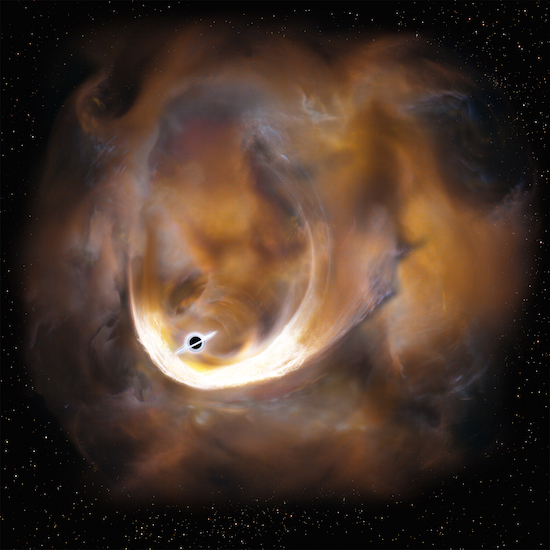Milky Way’s second-largest black hole?
Astronomers are calling it a possible first detection of an intermediate-mass black hole, a missing link in black hole evolution.

Astronomers in Japan have detected signs of the first-ever intermediate mass black hole in our Milky Way galaxy. They started with detailed observations of an enigmatic gas cloud, orbiting only 200 light-years – a hop and a skip on galactic distance scales – from the center of the Milky Way. They say the gas cloud might have been flung about by an intermediate mass black hole with a mass of 100 thousand times the mass of our sun. If so, this black hole may be a key to understanding the birth of supermassive black holes located in the centers of galaxies.
Astronomer Tomoharu Oka at Keio University in Japan led the research, which has been published in the Astrophysical Journal Letters. What makes this gas cloud – which has been labeled CO-0.40-0.22 – unusual is its surprisingly wide velocity dispersion. In the words, within this gas cloud, gas is flowing at a very wide range of speeds.
The team found this mysterious feature with two radio telescopes, the Nobeyama 45-m Telescope in Japan and the ASTE Telescope in Chile, both operated by the National Astronomical Observatory of Japan. Then they began probing the detail of its structure.
snip
Bottom line: Astronomers observed a strange gas cloud orbiting only 200 light-years from the center of our Milky Way galaxy. Within the cloud, various streams of gas are moving at a wide range of speeds. The astronomers ran computer simulations to see if something might have encountered the gas cloud and flung it outward, causing the motion of the gas. The best fit for the observations was a black hole of intermediate mass – with 100 thousand times the mass of the sun – which would be invisible, but possibly nearby. If that is the case, it is the first detection of an intermediate mass black hole.
http://earthsky.org/space/milky-ways-second-largest-black-hole?utm_source=EarthSky+News&utm_campaign=7c7da9f0c8-EarthSky_News&utm_medium=email&utm_term=0_c643945d79-7c7da9f0c8-394533365
